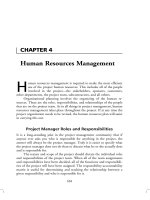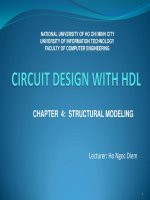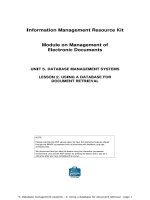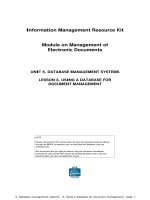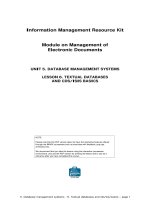Lecture Database management systems Chapter 4 Relational model
Bạn đang xem bản rút gọn của tài liệu. Xem và tải ngay bản đầy đủ của tài liệu tại đây (1.56 MB, 47 trang )
Chapter 4
Relational Model
Relational Model Concept
Relational database: a set of relations
Each relation resembles a table of values
Relation: made up of 2 parts
◦ Instance: a table, with rows and columns.
◦ Schema: specifies name of relation, plus name
and type of each column.
TheUser
terms commonly
Model usedProgrammer
Row
Column
Table
Tuple
Attribute
Relation
Record
Field
File
Relational Data Model
The relational model uses a collection of
tables to represent both data and the
relationships among those data.
Each relation resembles a table of values
Tables are logical structures maintained
by the database manager.
Ex:
STUDENT (NO., NAME, DATE_OF_BIRTH, GENDER)
Relation
Set of attributes
Relational Database
Ex:
◦ A row is called tuple.
◦ A column is called attribute.
◦ The table is called relation.
Relational Database
For each column of a table, there is a set
of possible values called its domain.
Domain is the set of valid values for an
attribute.
Relation Schema
Relation Schema R, denoted by R(A1, A2,…, An), is
made up of relation name R and a list of attributes A1,
A2, …,An
Each attribute Ai is the name of a role played by some
domain D in the relation schema R.
D is called the domain of Ai and is denoted by dom(Ai)
R is called the name of the relation
The degree of a relation is the number of attributes n of
its relation schema
Relational Algebra
Symbol
◦
◦
◦
◦
A1, A2, A3, … , An: attribute
D1, D2, D3, … , Dn : domain
R (A1:D1, A2:D2, …, An:Dn): relational model
r(R): relation
r = {t1, t2, t3, …, tn}
ti : tuple
Relational Data Model
The relational model is a combination of
three components:
◦ Structural Part: the database as a collection
of relations.
◦ Integrity Part: maintained in the relational
model using primary and foreign keys
◦ Manipulative Part: The relational algebra
and relational calculus are the tools used to
manipulate data in the database.
Concept of Key
An attribute or group of attributes, which
is used to identify a row in a relation.
Can be classified into 3 types:
◦ Super key
◦ Candidate key
◦ Primary key
Concept of Key
Super key:
◦ a subset of attributes of an entity-set that
uniquely identifies the entities.
◦ Represent a constraint that prevents two
entities from ever having the same value for
those attributes.
Concept of Key
Candidate key:
◦ a minimal super key.
◦ a minimal set of attributes whose values
uniquely identify tuples in the corresponding
relation.
Primary key:
◦ a designated candidate key.
◦ not be null
Foreign key:
◦ Set of fields or attributes in one relation that is
used to “refer” to a tuple in another relation.
Concept of Key
Ex: Employee characterized by these attributes:
◦
◦
◦
◦
◦
employee ID
employee name
employee age
employee experience
employee salary, etc.
Super keys can be: employee ID, employee
name, employee age, employee experience, etc.
Candidate keys can be: employee ID, employee
name, employee age.
Primary key: employee ID.
Concept of Key
Relational Query Languages
A major strength of the relational model:
supports simple, powerful querying of
data.
Queries can be written intuitively, and the
DBMS is responsible for efficient
evaluation.
The SQL Query Language is developed
by IBM in the 1970s
Relational Integrity
Four types of data integrity constraints:
◦
◦
◦
◦
Entity
NULL
Domain Integrity Constraint
Referential integrity.
Entity Integrity:
Imply that a primary key cannot accept
null value
Ex:
◦ The attributes of the entity PLAYER are
Name, Age, Nation, and Rank.
◦ If PLAYER’s name’s used as the primary key
cannot insert any data in the relation
PLAYER without entering the name of the
player.
Null Integrity
Imply that the data on attributes can be
NULL value are or are not permitted
Ex:
◦ The relation PERSON must have a valid, nonNULL value for the Name attribute, then
Name of PERSON is constrained to be NOT
NUL
Relational Integrity
Domain Integrity Constraint
◦ are based upon the semantics of the real world
enterprise that is being described in the
database relations.
◦ are used in the relational model to define the
characteristics of the columns of a table.
Ex:
◦ The age of the person cannot have any letter
from the alphabet. The age should be a
numerical value.
Relational Integrity
Referential Integrity
◦ a database must not contain any unmatched
foreign key values.
◦ not imply a foreign key cannot be null.
◦ Either each foreign key value must match a
primary key value in another relation or the
foreign key value must be null.
ER design to Relational
Entity sets to tables
Name
Age
Emp_ID
EMPLOYEE
CREATE TABLE Employees
(Emp_ID CHAR(11),
Name CHAR(20),
Age INTEGER,
PRIMARY KEY (Emp_ID))
EMPLOYEE (Emp_ID, Name, Age)
Relational Algebra
Query languages: Allow manipulation and
retrieval of data from a database.
Relational model supports simple, powerful
QLs:
◦ Strong formal foundation based on logic.
◦ Allows for much optimization.
Query
Languages
languages!
!=
programming
◦ QLs not intended to be used for complex
calculations.
◦ QLs support easy, efficient access to large data
sets.
Relational Algebra
Relational
algebra
Set Operations
Combined set
* Union ()
* Cartesian (x)
* Intersection () * Join (
)
* Difference (-)
* Rename (ρ)
Database
Operations
* Selection
* Projection
Selection
Work on a single relation R
Define a relation that contains only those
tuples of R that satisfy the specified
condition
Syntax:
σ <selection condition>(R)
◦ In selection condition:
Comparison operator : >, >=, <, <=, =, ≠
Relational operator: , , ¬
Selection
Ex:
Selection operation is associative.
Selection _ example
Student Roll. No
001
Name
GPA
Aravind
7.2
002
003
004
Anand
Balu
Chitra
7.5
8.2
8
005
006
007
Deepa
Govind
Hari
8.5
7.2
6.5
List all students who get GPA mark > 8
